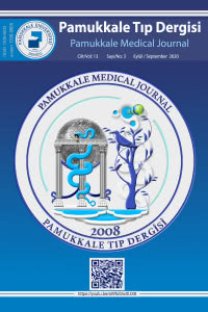2018 Uluslarası kanıta dayalı polikistik over sendromu değerlendirme ve yönetim rehberi doğrultusunda tanıdaki ‘yeniler’ ve ‘yineler’
polikistik over sendromu, amenore, obezite, insülin direnci
___
- Referans 1. Bozdag, G, Mumusoglu S, Zengin D, Karabulut E, Yildiz BO. The prevalence and phenotypic features of polycystic ovary syndrome: A systematic review and meta-analysis. Hum Reprod 2016;31:2841-2855.
- Referans 2. Ünlütürk U, Sezgin E, Yildiz BO. Evolutionary determinants of polycystic ovary syndrome: part 1. Fertil Steril 2016;106:33-41. https://www.doi.org/10.1016/j.fertnstert.2016.05.010.
- Referans 3. Szydlarska D, Machaj M, Jakimiuk A. History of discovery of polycystic ovary syndrome. Adv Clin Exp Med 2017;26:555-558. https://www.doi.org/10.17219/acem/61987
- Referans 4. Stein IF, Leventhal ML. Amenorrhoea associated with bilateral polycystic ovaries. Am J Obstet Gynecol 1935;29:181-191.
- Referans 5. International evidence-based guideline for the assessment and management of polycstic ovary syndrome 2018. monash.edu/medicine/sphpm/mchri/pcos.
- Referans 6. Kahsar-Miller MD, Nixon C, Boots LR, Go RC, Azziz R. Prevalence of polycystic ovary syndrome (PCOS) in first-degree relatives of patients with PCOS. Fertil Steril 2001;75:53-58.
- Referans 7. Goodman NF, Cobin RH, Futterweit W, Glueck JS, Legro RS, Carmina E; American Association of Clinical Endocrinologists (AACE); American College of Endocrinology (ACE); Androgen Excess and PCOS Society (AES). American Association of Clinical Endocrinologists, American College of Endocrinology, and Androgen Excess and PCOS Society Disease State Clinical Review: Guide to the practices in the evaluation and treatment of polycystic ovary syndrome- Part 1. Endocr Pract 2015;21:1291-1300. https://www.doi.org/10.4158/EP15748.DSC
- Referans 8. Asagami T, Holmes TH, Reaven G. Differential effects of insulin sensitivity on androgens in obese women with polycystic ovary syndrome or normal ovulation. Metabolism 2008;57:1355-1360. https://www.doi.org/10.1016/j.metabol.2008.05.002
- Referans 9. Rotterdam ESHRE/ASRM-Sponsored PCOS Consensus Workshop Group. Revised 2003 consensus on diagnostic criteria and long-term health risks related to polycystic ovary syndrome. Fertil Steril 2004;81:19-25. https://www.doi.org/10.1016/j.fertnstert.2003.10.004
- Referans 10. Azziz R, Carmina E, Dewailly D, et al. Criteria for defining polycystic ovary syndrome as a predominantly hyperandrogenic syndrome: An Androgen Excess Society guideline. J Clin Endocrinol Metab. 2006;91:4237-4245. https://www.doi.org/10.1210/jc.2006-0178
- Referans 11. Carmina E, Lobo RA. Do hyperandrogenic women with normal menses have polycystic ovary syndrome? Fertil Steril 1999;71:319-322.
- Referans 12. Geisthövel F, Rabe T. The ESHRE/ASRM consensus on polycystic ovary syndrome (PCOS)--an extended critical analysis. Reprod Biomed Online 2007;14:522-535.
- Referans 13. Yildiz, B.O, Bolour S, Woods K, Moore A, Azziz R. Visually scoring hirsutism. Hum Reprod Update, 2010;16:51-64. https://www.doi.org/10.1093/humupd/dmp024
- Referans 14. Borgia F, Cannavò S, Guarneri F, Cannavò SP, Vaccaro M, Guarneri B. Correlation between endocrinological parameters and acne severity in adult women. Acta Derm Venereol 2004;84:201-204. https://www.doi.org/10.1080/00015550410023248
- Referans 15. Dewailly D, Lujan ME, Carmina E, et al. Definition and significance of polycystic ovarian morphology: A task force report from the Androgen Excess and Polycystic Ovary Syndrome Society. Hum Reprod Update 2014;20:334-352. https://www.doi.org/10.1093/humupd/dmt061
- Referans 16. Cassar, S, Teede HJ, Moran LJ, et al. Polycystic ovary syndrome and anti-Mullerian hormone: Role of insulin resistance, androgens, obesity and gonadotrophins. Clin Endocrinol (Oxf) 2014;81:899-906. https://www.doi.org/10.1111/cen.12557
- Referans 17. Iliodromiti, S, Kelsey TW, Anderson RA, Nelson SM. Can anti-Mullerian hormone predict the diagnosis of polycystic ovary syndrome? A systematic review and meta-analysis of extracted data. J Clin Endocrinol Metab 2013;98:3332-3340. https://www.doi.org/10.1210/jc.2013-1393
- ISSN: 1309-9833
- Yayın Aralığı: Yılda 4 Sayı
- Başlangıç: 2008
- Yayıncı: Prof.Dr.Eylem Değirmenci
Pınar Canizci ERDEMLİ, Pınar TURHAN, Cengiz CANDAN
Kabızlık şikayeti ile gelen her çocuk hastadan tetkik istenmeli mi?
Lunate bone osteonecrosis in hemodialysis patient with rheumatoid arthritis: case report
Eser KALAOĞLU, Mürselin GÜLER, Derya BUĞDAYCI, Nurdan PAKER
Hemodiyalize giren romatoid artritli hastada lunat kemik osteonekrozu.
Nurdan PAKER, Derya BUĞDAYCI, Eser KALAOĞLU, Mürselin GÜLER
İzoniyazid intoksikasyonunda hemodiyalizin yeri
Ömer SALT, Mustafa Burak SAYHAN
Hemşirelik öğrencilerinin stresle başetme durumları ve madde kullanım öykülerinin belirlenmesi
Türkan TURAN, Gülay Taşdemir YİĞİTOĞLU, Gülbahar Korkmaz ASLAN, Asiye KARTAL
Onkoloji Hastalarında Kemoterapi öncesi HBsAg, AntiHBs ve izole AntiHBc pozitiflik oranları
Nagehan Didem SARI, Rıza Umar GÜRSU
Maternal faktörlerin prematür retinopatisindeki olası rolü
Buket DEMİRCİ, İmran Kurt ÖMÜRLÜ, Duygu GÜLER, Alparslan ÜNSAL, Ayşe İpek Akyüz ÜNSAL, Selda Demircan SEZER
Cerrahi sonrası iyileşmeyen kronik anal fissürlü hastalarda Botoks uygulaması başarılı mıdır?
MDS/MPN olgusunda klonal evolüsyon gösteren kompleks karyotip bulguları
Ayhan DEVİREN, Şeniz ÖNGÖREN, Seda EKİZOĞLU, R. Dilhan KURU, Ayşe ÇIRAKOĞLU, Şükriye YILMAZ, Yelda Tarkan ARGÜDEN
